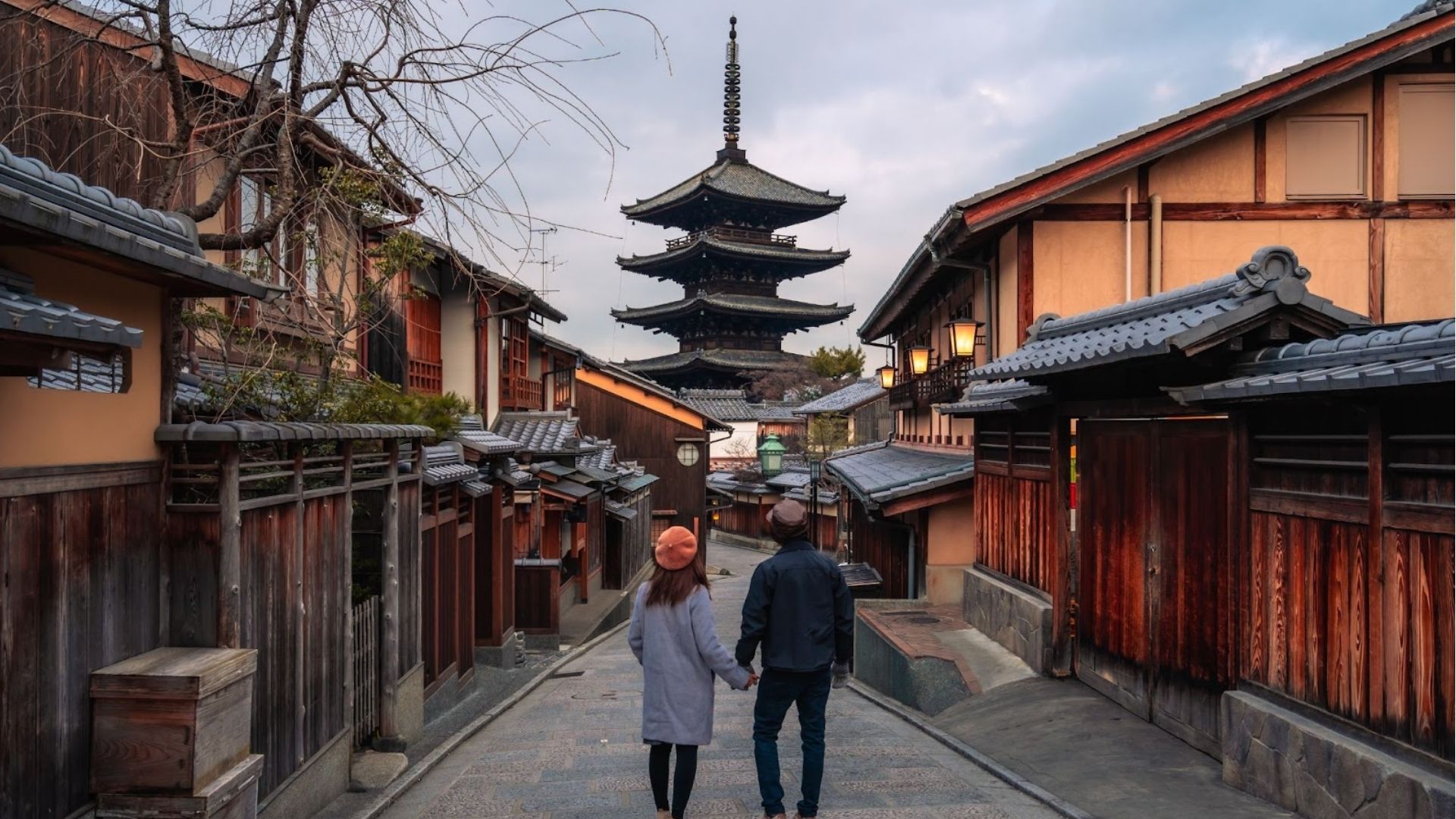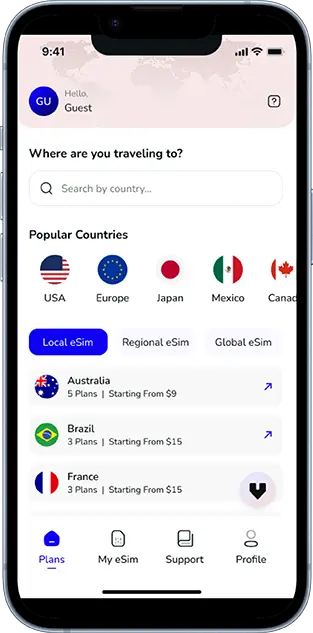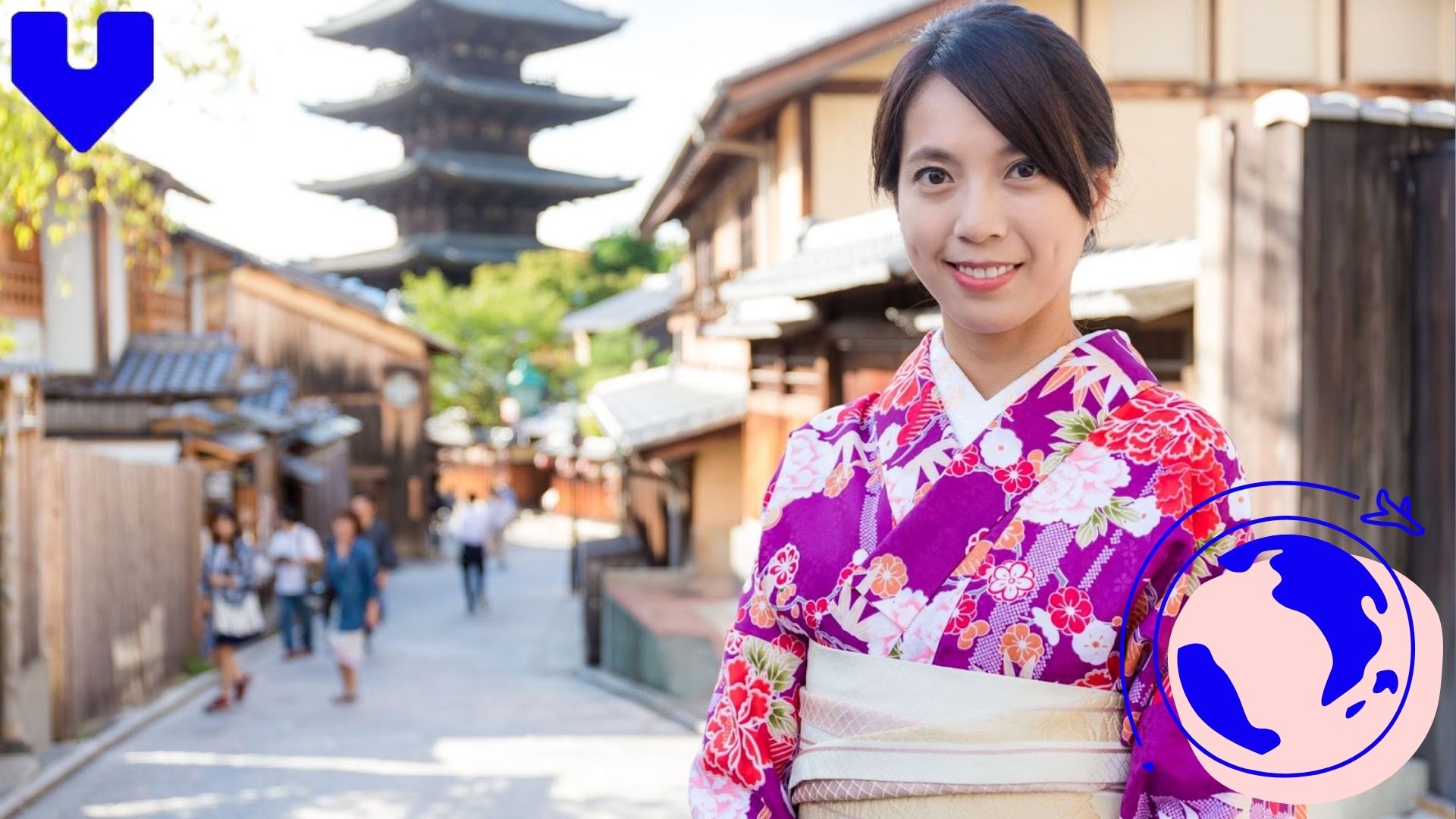Note that iPhone devices from Mainland China aren’t eSIM compatible. Also iPhone devices from Hong Kong and Macao aren’t compatible (except for iPhone 13 Mini, iPhone 12 Mini, iPhone SE 2020 and iPhone XS)
Tucked into the Kansai region of Japan, Kyoto is a city where the past and present exist in perfect harmony. Known as the cultural capital of the country, it offers an enchanting mix of ancient temples, meticulously designed gardens, and traditions that continue to shape everyday life. Unlike Tokyo’s fast-paced energy, Kyoto invites travelers to slow down, reflect, and embrace beauty in its most thoughtful forms. For those planning a short trip, the city delivers depth without demanding weeks of exploration, making it a perfect destination for a weekend escape or a two-day cultural immersion.
What makes a short trip to Kyoto so appealing is its balance of accessibility and variety. Within a compact area, you can walk through vermilion torii gates at Fushimi Inari, admire the golden glow of Kinkaku-ji, sip matcha in a traditional tea house, and wander the tranquil pathways of Zen gardens. The city rewards both the first-time visitor and the seasoned traveler, offering new layers of discovery with every corner turned. Whether you are drawn to spiritual traditions, natural landscapes, or culinary experiences, Kyoto captures it all. This blog will guide you through the highlights of temples, gardens, and tea culture while also providing practical tips for planning a seamless short trip.
Kyoto’s Timeless Appeal for Short Trips
Kyoto is often described as Japan’s cultural heart, a city that preserves the elegance of its past while embracing the conveniences of the present. For more than a thousand years, it served as the imperial capital, leaving behind an unparalleled collection of temples, gardens, and traditions that continue to shape its identity today. Even in the age of high-speed trains and neon cities, Kyoto remains a destination where time seems to move a little slower, inviting visitors to immerse themselves in heritage and beauty.
Why Kyoto Belongs on Every Traveler’s List
For many, Kyoto is the definition of Japan’s cultural essence. From the vermilion torii gates at Fushimi Inari to the serene raked stones of Ryoan-ji, the city embodies a kind of spiritual and artistic refinement that feels uniquely Japanese. It is where centuries-old tea ceremonies are still practiced, and where geisha culture continues to thrive in the lantern-lit alleys of Gion. These experiences are concentrated within a city that is manageable in size, making Kyoto an ideal choice for a short trip that still feels transformative.
Accessibility and Convenience
Part of Kyoto’s appeal is how easy it is to reach. Thanks to Japan’s efficient rail system, the city is just a short Shinkansen ride from Tokyo or Osaka. Travelers arriving at Kansai International Airport can also reach Kyoto quickly, making it possible to step into a completely different atmosphere within hours of landing in Japan. Once inside the city, public buses, subways, and walking routes connect all major attractions, ensuring that you spend less time commuting and more time exploring. This accessibility is one of the reasons Kyoto consistently tops lists of weekend and short-trip destinations.
Compact Yet Diverse
What makes Kyoto perfect for shorter visits is how much variety is packed into its districts. Within a couple of days, you can admire the gold-leaf brilliance of Kinkaku-ji, climb the slopes to Kiyomizu-dera for sweeping city views, and lose yourself in the bamboo groves of Arashiyama. The experiences are distinct yet complement one another, giving you a well-rounded impression of Kyoto without requiring weeks of exploration. Whether you are focused on spiritual sites, nature escapes, or culinary delights, Kyoto offers a compact journey that feels expansive in meaning.
Atmosphere That Lingers
Beyond its landmarks, Kyoto captivates travelers with an atmosphere that lingers long after the trip ends. There is something meditative about watching monks sweep temple courtyards at dawn, or hearing the rustle of leaves in a garden designed centuries ago. Even a simple cup of matcha, prepared with precision and care, feels like a cultural experience. These moments are what make Kyoto stand out among global destinations – its beauty is not only seen but felt.
A short trip to Kyoto allows travelers to experience Japan’s traditions at their most authentic. Its accessibility, variety, and enduring atmosphere ensure that even in just two or three days, the city leaves an impression as deep as destinations that take weeks to explore. Kyoto’s timeless appeal lies in its ability to make a brief journey feel like a complete cultural immersion.
Exploring Kyoto’s Temples and Shrines
Kyoto is home to more than 1,600 Buddhist temples and 400 Shinto shrines, a density that reflects its long history as Japan’s spiritual center. For travelers on a short trip to Kyoto, it’s impossible to see them all, but carefully choosing a few highlights gives you a profound glimpse into the city’s sacred identity. The blend of grand landmarks and quiet neighborhood shrines ensures that every visitor experiences both spectacle and serenity.
Temple Hopping in Kyoto’s Historic Districts
Kyoto’s temples are spread across districts, each with its own atmosphere. Eastern Kyoto (Higashiyama) is rich with iconic sites like Kiyomizu-dera, while the northern districts boast the shimmering Golden Pavilion, or Kinkaku-ji. Western Kyoto offers more tranquil escapes, like Tenryu-ji in Arashiyama. This geographic variety allows travelers to tailor their temple visits according to their interests and time, making temple-hopping a rewarding activity even on a short visit.
Fushimi Inari Taisha: Gates to the Divine
Perhaps Kyoto’s most famous shrine, Fushimi Inari Taisha, is instantly recognizable for its thousands of vermilion torii gates winding up the wooded slopes of Mount Inari. Dedicated to Inari, the Shinto god of rice and prosperity, this site is open 24 hours, giving visitors the chance to explore at dawn or under lantern light at dusk. Walking through the gates is an experience that feels both spiritual and cinematic, making it a must for any short trip itinerary.
Kiyomizu-dera: A View Over Kyoto
Perched on the slopes of Higashiyama, Kiyomizu-dera is a Buddhist temple famous for its wooden stage that juts out over the hillside, offering panoramic views of the city. Built without nails, the structure itself is a marvel of engineering. In spring, cherry blossoms surround the temple, while autumn paints the landscape in vivid red and gold. For visitors with limited time, this temple delivers both architectural wonder and breathtaking scenery in one stop.
Kinkaku-ji: The Golden Pavilion
No short trip to Kyoto is complete without seeing Kinkaku-ji, the Golden Pavilion. This Zen temple is covered in gold leaf and reflected beautifully in the surrounding pond, creating one of Japan’s most iconic images. Originally built as a retirement villa for a shogun, it is now a UNESCO World Heritage site that draws travelers from around the world. Despite its popularity, the serene garden paths ensure visitors still find moments of peace while walking through.
Smaller Shrines for Quiet Reflection
While the famous temples capture attention, Kyoto is also filled with smaller shrines that offer intimate glimpses of local devotion. Yasaka Shrine in Gion is a vibrant spot, especially during festivals, while Heian Shrine is known for its spacious grounds and striking torii gate. Even tucked-away neighborhood shrines provide a chance to step away from the crowds and enjoy a few quiet minutes of reflection.
Exploring Kyoto’s temples and shrines is more than a checklist of attractions – it’s an invitation to engage with traditions that have endured for centuries. Each site, whether grand or modest, tells a story about the city’s role as Japan’s spiritual heart. For travelers on a short visit, a thoughtful mix of iconic landmarks and lesser-known shrines ensures a journey that feels both comprehensive and personal.
Connect Instantly in Japan
Activate your Kyoto eSIM in just a few minutes.
Gardens and Nature Retreats in Kyoto
While Kyoto is best known for its temples and shrines, its gardens and natural landscapes are equally captivating. Designed with meticulous care, these spaces invite visitors to slow down, reflect, and embrace a sense of harmony with nature. A short trip to Kyoto feels complete when you balance architectural wonders with the tranquility of its gardens and outdoor retreats.
Finding Serenity in Kyoto’s Gardens
Gardens in Kyoto are more than decorative spaces – they are carefully constructed expressions of Zen philosophy and aesthetic balance. Rocks, water, moss, and plants are arranged with purpose, creating scenes that change with each season. Unlike the grandeur of temples, gardens emphasize subtle beauty, encouraging quiet observation. Spending even a short time in these settings offers travelers a chance to connect with Kyoto’s deeper cultural spirit.
Ryoan-ji: The Zen Rock Garden
Perhaps the most famous of Kyoto’s gardens is Ryoan-ji, a Zen temple with a minimalist rock garden that has inspired contemplation for centuries. Fifteen stones are arranged across raked white gravel, designed so that no matter where you stand, only fourteen are visible at once. The simplicity invites reflection, and visitors often sit quietly for long stretches, allowing the garden to shape their thoughts. For those on a short trip, Ryoan-ji offers an accessible glimpse into Zen aesthetics at their purest.
Arashiyama Bamboo Grove
On Kyoto’s western edge, Arashiyama presents one of the city’s most iconic natural scenes: the Bamboo Grove. Walking through towering stalks that sway gently with the wind creates an almost otherworldly atmosphere. The nearby Togetsukyo Bridge provides sweeping views of the Katsura River, especially beautiful during autumn foliage or spring blossoms. This area combines natural beauty with cultural landmarks like Tenryu-ji Temple, making it a rewarding stop for travelers with limited time.
Kyoto Imperial Palace Park
For a broader natural retreat, the Kyoto Imperial Palace Park offers spacious grounds where locals jog, families picnic, and visitors wander among seasonal blooms. Cherry blossoms in spring and vivid leaves in autumn transform the park into a living painting. Its size and openness provide a contrast to the intimate scale of Zen gardens, giving travelers the chance to enjoy Kyoto’s greenery on a larger scale.
Seasonal Magic in Kyoto’s Nature
One of the most rewarding aspects of Kyoto’s gardens and nature is how they change with the seasons. In spring, cherry blossoms blanket temple paths and riversides. Summer brings lush greenery, while autumn transforms the city into a canvas of fiery reds and oranges. Winter adds its own quiet beauty, with snow dusting temple roofs and gardens. Even a short visit captures some of this magic, offering travelers seasonal memories that feel timeless.
Kyoto’s gardens and natural retreats add balance to any trip. They complement the city’s temples by offering quiet spaces where the focus shifts from grand structures to subtle landscapes. For travelers on a short trip, combining temple visits with time spent in gardens ensures a well-rounded experience that captures both the spiritual and natural essence of Japan’s cultural capital.
Matcha Moments: Kyoto’s Tea Culture and Culinary Delights
Kyoto is not only the city of temples and gardens but also the birthplace of many of Japan’s most treasured culinary traditions. Among them, matcha tea holds a special place, symbolizing both hospitality and mindfulness. For travelers on a short trip, indulging in tea ceremonies, tasting local delicacies, and exploring markets provides a flavorful layer to the Kyoto experience.
Sipping Matcha in the Heart of Kyoto
Kyoto’s association with matcha runs deep, especially in the district of Uji, just outside the city. Uji is famous for producing some of Japan’s highest-quality green tea, and tea shops here have perfected their craft over centuries. In Kyoto proper, traditional tea houses invite visitors to sit quietly as a host prepares powdered green tea with deliberate, graceful movements. Participating in a tea ceremony is more than drinking tea – it is a cultural ritual emphasizing respect, tranquility, and mindfulness.
Nishiki Market: Kyoto’s Kitchen
Known as “Kyoto’s Kitchen,” Nishiki Market is a must-visit for anyone seeking local flavors. Stretching for several blocks, this covered market is lined with stalls offering everything from pickled vegetables and tofu to skewered seafood and sweets. Matcha appears here too, in the form of ice creams, cakes, and candies. Wandering Nishiki Market provides a sensory journey through Kyoto’s culinary heritage, making it a great stop for short-trip travelers eager to taste a wide range of specialties in one place.
Kaiseki: The Art of Dining
For those looking for a more formal experience, Kyoto is the home of kaiseki, a multi-course meal considered the pinnacle of Japanese dining. Kaiseki emphasizes seasonal ingredients, artistic presentation, and balance in taste and texture. While it can be elaborate, some restaurants offer shorter kaiseki courses suited to travelers with limited time. Experiencing even a simplified version of this tradition provides insight into Kyoto’s deep connection to food as both art and philosophy.
Street Food and Casual Bites
Not all food in Kyoto requires formality. Street vendors near temples and popular districts serve snacks that are perfect for quick energy during sightseeing. From yatsuhashi (a sweet made of rice flour and cinnamon) to takoyaki (octopus balls) and taiyaki (fish-shaped cakes filled with red bean paste), Kyoto offers plenty of casual treats. Matcha-flavored versions of these snacks are especially popular, giving travelers the chance to enjoy a familiar food with a Kyoto twist.
Culinary Experiences Beyond Eating
Food culture in Kyoto also extends into experiences like cooking classes, where visitors can learn to make sushi, soba noodles, or wagashi (traditional sweets). These classes provide hands-on ways to engage with local traditions and bring a piece of Kyoto back home. Even brief encounters with these activities make a short trip feel richer, connecting travelers to the everyday life of the city.
Kyoto’s culinary landscape ensures that every short trip is filled not only with sights but also with flavors. From the meditative calm of a tea ceremony to the lively bustle of Nishiki Market, food becomes a central part of how you experience the city. For travelers, matcha moments and culinary delights offer a taste of Kyoto that lingers long after the trip ends.
Planning Your Short Trip: Itinerary, Tips, and Connectivity
Kyoto may be filled with centuries of history, but it’s also one of Japan’s most traveler-friendly destinations. With a bit of planning, you can fit temples, gardens, tea culture, and food experiences into a short trip without feeling overwhelmed. Here’s how to make the most of a couple of days in Japan’s cultural capital.
Best Time to Visit Kyoto
Kyoto is beautiful year-round, but certain seasons add extra magic to a short trip. Spring (late March to April) brings cherry blossoms, making temple walks especially scenic. Autumn (October to November) transforms gardens and hillsides with vibrant red and gold foliage. Summer offers lively festivals, such as Gion Matsuri, though the weather can be hot and humid. Winter is quieter, with fewer crowds and the chance to see temples dusted with snow. For most travelers, spring and autumn are the most rewarding seasons.
Getting Around the City
Kyoto’s layout makes it easy to explore. Buses and subways connect most major attractions, while taxis are convenient for shorter stays when time matters. Many travelers also enjoy walking between sites, especially in districts like Higashiyama and Arashiyama, where the journey itself feels like part of the experience. Comfortable shoes are essential, as cobblestoned temple paths and long market streets are best enjoyed at a relaxed pace.
Suggested Two-Day Itinerary
Day One: Start early at Fushimi Inari Taisha to walk through the torii gates before crowds arrive. Head to Kiyomizu-dera for panoramic city views, then spend the afternoon in the Higashiyama district exploring narrow streets and sampling local snacks. End the day in Gion, watching lanterns glow as geisha walk to evening appointments.
Day Two: Begin in Arashiyama with the Bamboo Grove and Tenryu-ji Temple. Cross Togetsukyo Bridge for river views, then visit Kinkaku-ji, the Golden Pavilion, in the afternoon. Conclude your trip with a tea ceremony or a stroll through Nishiki Market for matcha ice cream and souvenirs.
This balanced plan ensures you see Kyoto’s most iconic sights while leaving space for spontaneous discoveries.
Stay Online During Your Kyoto Adventure
Navigating buses, finding temple opening hours, and locating hidden tea houses all depend on having reliable internet. That’s where a Voye Global eSIM for Japan proves invaluable. Instead of searching for local SIM cards or dealing with expensive roaming fees, you can activate your eSIM instantly and arrive in Kyoto ready to connect.
The eSIM provides nationwide coverage, so whether you’re wandering the bamboo groves of Arashiyama or exploring Uji’s tea houses, you’ll stay online seamlessly. For short trips, this convenience saves precious time and ensures you can focus on experiences rather than logistics. Sharing photos, translating menus, or checking train schedules becomes effortless with stable data at your fingertips.
Travel Without Roaming Fees
Save money with reliable eSIM data across Japan.
Budget and Essentials
Kyoto caters to a wide range of budgets. Heritage guesthouses, modern hotels, and traditional ryokan inns all offer options for accommodation. Food ranges from street snacks for a few hundred yen to multi-course kaiseki dinners. Essentials for a short trip include light clothing in summer, layers in cooler months, and a camera to capture the city’s photogenic charm. Most importantly, keep your itinerary flexible enough to enjoy Kyoto’s slower rhythm – a city that rewards both careful planning and unplanned exploration.
With the right timing, reliable connectivity, and a thoughtful itinerary, a short trip to Kyoto becomes a journey into Japan’s cultural soul. It’s a destination that leaves you with memories not just of places visited but of moments felt.
Conclusion

Kyoto proves that a short trip can be just as enriching as a longer journey. In only two or three days, travelers can wander through ancient temples, pause in tranquil gardens, savor matcha in traditional tea houses, and explore bustling markets filled with local flavors. The city’s manageable size, combined with its cultural depth, ensures that even a weekend escape feels like a full immersion into Japan’s timeless traditions.
What makes Kyoto unforgettable is not just its landmarks but the quiet moments it inspires – the hush of a bamboo grove, the artistry of a tea ceremony, or the view from a temple terrace at sunset. With thoughtful planning and seamless connectivity, a short trip to Kyoto becomes a collection of experiences that capture the essence of Japan’s cultural capital, leaving memories that linger long after you return home.
FAQs
1. How do I activate a Voye Global eSIM for Japan before traveling?
You can purchase it online, scan the QR code, and instantly connect when you land in Japan.
2. What is the best time to plan a short trip to Kyoto?
Spring and autumn are ideal, with cherry blossoms and fall foliage making the city especially scenic.
3. Does Voye Global eSIM provide strong coverage across Kyoto?
Yes, it offers stable multi-network coverage not only in Kyoto but across Japan.
4. How many temples can I realistically visit in two days?
In a short trip, you can comfortably explore three to five iconic temples without feeling rushed.
5. Can I share data from my Voye Global eSIM with other devices?
Yes, your phone can act as a hotspot, letting you connect laptops or tablets.
6. Which Kyoto garden is a must-see for first-time visitors?
Ryoan-ji’s Zen rock garden and Arashiyama’s Bamboo Grove are the most iconic choices.
7. Is Voye Global eSIM cheaper than using roaming services in Japan?
Yes, it saves you from high roaming charges while providing instant and reliable connectivity.
8. What food experiences should I not miss in Kyoto?
Matcha tasting, kaiseki dining, and browsing Nishiki Market are essential culinary highlights.
9. Can I activate my Voye Global eSIM before leaving my home country?
Yes, activation before departure is recommended so you’re online the moment you arrive.
10. Is Kyoto worth visiting for a weekend compared to Tokyo?
Yes, Kyoto’s compact size, cultural focus, and slower pace make it ideal for short trips, while Tokyo suits longer urban explorations.

Seamless Mobile Data Everywhere

















